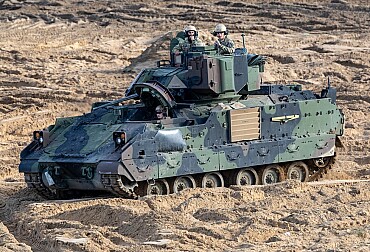The New US B61-13 Gravity Bomb: Balancing Deterrence in a Dynamic Nuclear Era
The US Department of Defense's recent announcement about the development of the B61-13, a modern variant of the B61 nuclear gravity bomb, has sparked interest and discussions among defense analysts, policymakers, and the general public. This article aims to provide a comprehensive understanding of the B61-13, its significance, and its role in the broader context of U.S. nuclear policy.

The Changing Security Landscape
The 2022 Nuclear Posture Review (NPR) underscored a significant shift in the global security environment. Several factors contribute to this evolving landscape:
-
Emerging Nuclear Powers: Over the past few decades, more nations have sought to develop or acquire nuclear capabilities. This proliferation not only increases the number of nuclear-armed states but also introduces new dynamics in regional power balances.
-
Modernization Efforts by Competitors: Established nuclear powers, particularly U.S. competitors, have been aggressively modernizing their arsenals. This includes the development of new delivery systems, miniaturization techniques, and advanced missile defense countermeasures. Such advancements can potentially undermine the U.S.'s ability to deter adversaries effectively.
-
Shift in Doctrines: There's a noticeable shift in the nuclear doctrines of some states, emphasizing the early use of nuclear weapons in a conflict. Such a change in stance increases the risk of nuclear escalation in regional conflicts.
-
Technological Advancements: The integration of emerging technologies, such as artificial intelligence, cyber capabilities, and hypersonic weapons, into military strategies has added another layer of complexity. These technologies can potentially disrupt traditional nuclear deterrence dynamics, making it imperative for the U.S. to adapt its strategies.
-
Geopolitical Tensions: Regional tensions, particularly in areas like the South China Sea, the Korean Peninsula, and Eastern Europe, have heightened the risk of conflicts that could escalate to nuclear proportions. These tensions necessitate a robust and flexible nuclear posture to deter potential adversaries.
-
Erosion of Arms Control Agreements: The past years have witnessed the erosion or abandonment of several arms control agreements. Such developments can lead to unchecked arms races and reduce the predictability and stability that these agreements once provided.
In light of these challenges, the U.S.'s decision to develop the B61-13 is not merely about adding another weapon to its arsenal. It's about ensuring that its nuclear posture is responsive, resilient, and relevant in a world where the old rules and assumptions no longer apply. The changing security landscape demands a recalibration of strategies, and the B61-13 is a part of that broader strategic adaptation.
The Role of the B61-13
The B61-13 is not just another addition to the U.S. nuclear arsenal. It's a strategic move aimed at enhancing the country's deterrence capabilities. Here's what sets the B61-13 apart:
-
Flexibility: The B61-13 will replace some of the older B61-7s, inheriting its higher yield. However, it will also incorporate the modern safety, security, and accuracy features of the B61-12. This combination ensures that the U.S. has a more versatile weapon in its arsenal.
-
Targeting Capabilities: The B61-13 is designed to provide additional options against harder and large-area military targets. This capability is crucial in a world where adversaries might use deeply buried facilities to shield critical assets.
A Balanced Nuclear Strategy
The U.S.'s approach to its nuclear arsenal has always been a delicate balance between ensuring national security and promoting global disarmament. The development of the B61-13 is a testament to this nuanced approach. Here are the key elements that highlight the balanced nature of this strategy:
-
Modernization with Limitation: While the U.S. recognizes the need to modernize its nuclear arsenal to address evolving threats, it's equally committed to not increasing the overall number of weapons. The introduction of the B61-13, for instance, will be offset by a corresponding reduction in the production of the B61-12. This ensures that while the U.S. maintains a state-of-the-art arsenal, it doesn't contribute to a global arms race.
-
Retirement of Legacy Systems: The U.S. continues to phase out older, less efficient nuclear systems. The planned retirement of systems like the B83-1 and the B61-7 is a clear indication of the U.S.'s commitment to reducing the number of active nuclear weapons over time.
-
Commitment to Arms Control: The U.S. remains dedicated to international arms control agreements and treaties. While modernizing its arsenal, the U.S. also actively engages in diplomatic efforts to promote nuclear disarmament and non-proliferation. This dual approach ensures that while the U.S. is prepared for current threats, it also works towards a future with reduced nuclear risks.
-
Transparency and Communication: A balanced strategy is not just about numbers or capabilities; it's also about communication. The U.S. maintains a transparent approach to its nuclear policy, ensuring that allies are reassured, adversaries are deterred, and the global community is informed. This openness reduces the risk of misunderstandings and miscalculations.
-
Holistic Defense Posture: The U.S.'s nuclear strategy is just one component of its broader defense posture. While the B61-13 enhances the nuclear deterrence capability, the U.S. also invests in conventional forces, missile defenses, and emerging technologies. This multi-faceted approach ensures that the U.S. has a range of options to address various threats, reducing the reliance on nuclear weapons as the primary deterrent.
In essence, the U.S.'s nuclear strategy is a reflection of its broader commitment to global security and stability. The development of the B61-13, while ensuring that the U.S. remains prepared for contemporary challenges, is also a step towards a safer, more stable global environment.
A Proactive, Not Reactive, Measure
It's essential to understand that the B61-13's development isn't a knee-jerk reaction to a specific event or threat. Instead, it's a result of months of review and consideration, reflecting a proactive approach to a changing security environment.
Conclusion
The introduction of the B61-13 into the U.S. nuclear arsenal is more than just a strategic military decision; it's a reflection of the nation's evolving stance in a rapidly changing global landscape. As the dynamics of international relations shift, with emerging nuclear powers and technological advancements, the U.S. finds itself at a crossroads. The choice isn't merely about maintaining dominance but about ensuring stability, security, and peace.
The B61-13 represents a synthesis of lessons from the past and preparations for the future. By combining the best features of its predecessors and adapting to the current security challenges, the U.S. is signaling its commitment to a balanced approach. This approach respects the importance of deterrence while also acknowledging the ultimate goal of a world with fewer nuclear weapons.
Furthermore, the development of the B61-13 underscores the importance of adaptability. In a world where threats are multifaceted and ever-evolving, the ability to adapt, innovate, and recalibrate strategies is paramount. The U.S.'s decision to develop the B61-13, while also retiring older systems and maintaining a transparent dialogue, exemplifies this adaptability.
In the broader context, the B61-13 serves as a reminder of the delicate balance nations must strike between defense and diplomacy. As the U.S. continues to navigate the complexities of the 21st century, the B61-13 stands as a testament to its commitment to safeguarding its interests, reassuring its allies, and promoting a stable international order.







